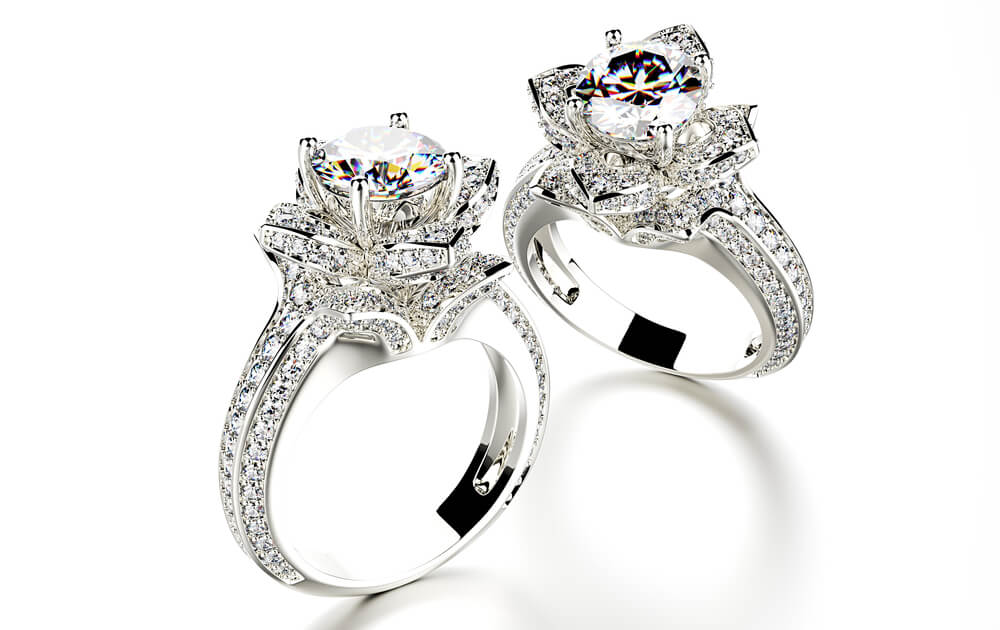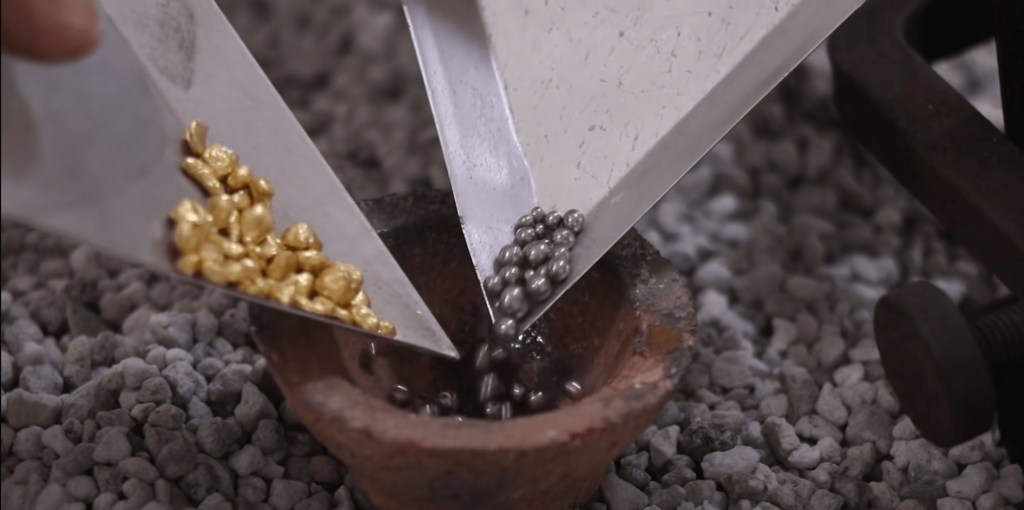Introduction to white gold
A precious solution when beauty fuses with dexterity as well as strength, white gold has found its perfectly safe place in the kingdom of jewelry. Contrary to the name, white gold is not the pure metal but a natural alloy achieved by combining gold with one or more white metals. The elegant material was introduced as an alternative to the rarer and pricier platinum in early 19th century.
What is White Gold?
White gold is a combination of pure gold and other white metals inclusive of palladium, nickel, or silver. What makes white gold special forms the color, strength, and affordability it gives beside making it one of the most demanded pieces of jewellery in the world.
White Gold History and Origin
The history of white gold dates back to the 19th century. The quest for a platinum look-alike which would be less expensive as well as not scarce-looking sprung forth this alluring alloy. The combination of yellow gold with white metals thus brought a new precious metal that had the same aesthetic look like platinum but at much cheaper costs.

How White Gold Was Created
Making white gold is a very complex process, in which pure yellow gold is alloyed with other metals that are white to give the gold its appearance as well as reinforcements.
How Exactly White Gold is Made and What is Made up of?
The process of the making white gold involves the careful proportioning and measuring of gold and other constituents of the alloy. Usually, about 75% of this composition constitutes yellow gold and the remaining 25% comprises another variety of white metal such as palladium, nickel or silver. These various metals are melted together after being measured at high temperatures and mixed until complete homogenization. The resultant alloy is the heated liquid, which is cooled in molds to form bars, for example, 10pt gold ready for crafting different ornaments of jewelry.
Functions of Various Alloys Used in White Gold Composition
The different alloys used to make white gold not only give it its distinct white tint but also help to strength it. For example, palladium or nickel will make the gold take on a white appearance while adding copper gives its strength. This composition can be slightly varied, which affects the final colour and strength of the white gold.
Properties of White Gold
The attributes of white gold are defined by the properties of the metals that make it up. These include its aesthetics, durability and in comparison to other precious metals white gold is definitely a favorite for many a precious jewelry enthusiast.
White Gold Attributes
The color of white gold can vary from light, silvery white to a deeper, more muted gray, depending on the type and ration of metals that make up the mix. Sometimes, an extra layer of rhodium is applied on its surface to enhance durability and increase brightness. After use for a long time, this extra layer may wear out, exposing the natural color of the white gold, which can be re-plated sometimes.
Strength and Durability of White Gold
White gold tends to be more durable than yellow gold given the strength of the other metals in the alloy. With this regard, it stands up very well to daily wear and tear compared to yellow gold. White gold can maintain its luster if proper care is followed and maintained during a long time period.
Comparison of white gold with other precious metals
It is more affordable than other expensive metals like platinum but provides a strikingly similar appearance. However, it needs to be re-plated with rhodium after regular intervals, so it may demand more maintenance compared to platinum.
What Does White Gold Look Like, and What Makes It White?
White gold exhibits a white-silver, lustrous look from light white to pale gray-white shades. The reason behind this white appearance in the metal is ascribable to yellow gold combined with palladium, nickel or silver alloys, and ion-plated rhodium that gives it an enormous white color as well.
White Gold in Jewelry
The reasons white gold has been used in making jewelry is because first, of its appealing appearance as well as high durability of the material, and second, comparative price affordability in comparison to other metals.
What Makes White Gold Popular in Jewelry Making?
White gold’s sleek, stylish appearance combined with its toughness makes it an excellent material to craft out different jewelry pieces. Its neutral color adds brilliance to diamonds and other gemstones that are placed on it making those gemstones stand out or more pronounced. Moreover, it is relatively cheaper compared to platinum and thus quite affordable by many people.
The Kind of Jewelry that Comprises White Gold
White gold is normally used in making engagement rings, wedding bands, necklaces, bracelets as well as earrings. This fashion of gold can be found in fine watches and jewelry. Versatility of white gold can range from multi-tone design which gives a beautiful contrast with yellow or rose gold.
White Gold Care
Maintenance of white gold jewelry
Routine cleaning of white gold jewelry is important so as to maintain its shine. Effective cleaning of such pieces may be by using a mild soap and warm solution of water that can ideally do away with the dirt on the piece while being gentle in scrubbing the piece with a soft cloth. However, since harsh chemicals often corrode the rhodium plating in addition to attacking the underlying metals, they need to be avoided. Even to further maintain their durability, one could consider taking white gold pieces off before involving themselves in physical activities or any kind of contact with strong chemicals.
Process of Rhodium Plating and its Purpose
Rhodium plating is a method of depositing a thin layer of rhodium, a member of the platinum group metal, unto the surface of white gold jewelry. This process brightens the whiteness in the appearance of jewelry while functioning as a protection from tarnish. However, note that with time, the layer of the rhodium can wear off and may therefore periodically require re-plating every now and then.
White Gold vs. Yellow Gold and Platinum
Differences and Comparison of Appearance, Composition, and Price
White gold, being yellow gold alloyed with other metals, presents an edge of dexterity to color as compared to simply having yellow gold as it is. Where yellow gold has its warm golden hue, white gold and platinum share a similarly lustrously white color. All three metals feature compositionally gold, though with which the alloy differs with which it becomes combined. For example, the yellow gold is alloyed using metals like copper or silver and white gold is also alloyed with white metals such as palladium or nickel. Unlike this, platinum is usually white and denser hence quite expensive. In this view, platinum is generally the most expensive of the three metals, followed by white gold and then yellow gold accordingly.
Uses for All
Depending on your desired look and specific situational usage, there are uses to both white gold, yellow gold, and platinum. For instance, white gold is ideal for engagement rings and wedding bands due to its sturdiness and modern style. Yellow gold brings an appeal that is classic and vintage that best suits timeless pieces while platinum offers durability as its natural white makes it perfect for luxury jewelry even heirloom.

Ethical Considerations and Sustainability
Environmental impact of mining white gold
Mining gold and other metals necessary to make white gold has numerous environmentally destructive impacts, such as deforestation, loss of biodiversity, and damage inflicted upon waterways. The emphasis in taking responsible mining practices cannot be emphasized enough.
Ethical Jewelry Brands Focused on Sustainable Sourcing
It also comes in different compositions depending on the brand. Nevertheless, for popular brands such as Brilliant Earth, Vrai, and Ana Luisa, ethical sourcing standards are observed. They either use recycle or fair trade gold in manufacturing their jewelry items thus ecologically-sensitive.
Allergic Reactions and Hypoallergenic Properties
Whose Possibility is an Allergic Reaction to White Gold?
Allergic reactions to the white gold are rather rare though possible and are often related to the nickel component constituting the alloy.
Nickel in White Gold and Possible Allergenic Reactions
The people who are prone to nickel allergy, they will find that their skin gets red or itchy on wearing white gold jewelry since it always has a slight content of nickel. For such people, it is advised not to wear this type but should go for white gold jewelry which is made with entirely different white metals than palladium.The Future of White Gold
Emerging Trends and Designs in White Gold Jewelry
Trends in white gold jewelry design today are driven by minimalism and geometrics, also personalized pieces, multi-tone combining white, yellow, and rose golds. That gives limitless opportunities for clients to righteously express their taste.
Innovations in White Gold Production and Sustainability
These efforts at increasing vigilance towards the environment take us to white gold which is mined and recycled in a more sustainable way. Moreover, another eco-friendly option available to the environmentally conscious customers along with white gold are lab-grown gemstones.
White Gold in Different Cultural Contexts
Significance of White Gold in Different Cultural Contexts
The white gold finds its special place where contemporary neutral elegance of culture exist in terms of jewelry amidst distinct cultural realms at large. Growing up within Western cultures, white gold is known to fit the wearer’s taste but still has classic relevance when linked with wedding and engagement jewelry. Versatile yet sophisticated, this cool hue stands testament to a perfect choice of such a special selection of pieces. Naturally, in Eastern societies, yellow gold is revered for its symbolic value as a bearer of the energy of the sun, wealth luck, and unpolluted properties. The effect of globalization and the pinpoint Western fashion trends, however, has also inched some acceptance of white gold in these societies by redefining the accepted traditional norms.
Use of White Gold in Traditional or Ceremonial Jewelry across the Cultures
Though yellow gold still takes its place in ceremonial and traditional pieces, white gold has been steadily gaining acknowledgment with the development of communities and diversification of taste. In some modern interpretations of traditional designs, craftsmen actually paint on a layer of white gold to serve as a canvas, allowing ethnic themes and motifs to sparkle through while offering a classic look with a contemporary twist.
Understanding Karats in White Gold
Definition of Karats
Karats can be defined as the DNA of gold jewelry – it discloses what makes up a piece of gold. A karat signifies 1/24th part of the whole, making it if it is made of 24 parts per 24 there are no other metals inside it apart from gold.
The lower karat count, the more other metals or alloys are present in the blend.Application of the Karat System towards White Gold
With white gold, the karat system just represents an amount of pure gold present in the mixture. For example, 18K white gold contains about three-quarter content of gold while the rest comprises white metals such as palladium or nickel. Karatage contributes to the all-round strength, value, as well as color of the piece of jewelry.

Fashion of White Gold
The Importance of White Gold in the Contemporary Fashion Scenario
Any contemporary fashion cannot find its end without the white gold featuring on top as a vogue sweetheart. Its sleek, neutral shade carries it through changing styles, fashions, and color trends from minimalist chic to opulent luxury. It’s at home in a casual daytime setting just as it is shining beneath the glittering lights of an evening gala.
Remarkable Pieces of Fashion Jewelry under White Gold
In various high profile events donned by not just celebrities but also models, white gold has had the spotlight. Who can forget Halle Berry’s dazzle with white gold and diamond fringe earrings on Oscar night in 2002, or the wrist of the Duchess of Windsor graced by the iconic Panthère bracelet in white gold and diamonds from Cartier. These pieces bring about an emphasis in that white gold is effective in bringing out a kind of elegance and showmanship of exemplary proportions.
Health and Safety of White Gold
Safety that an Individual get from Wearing White Gold
Although white gold is a safe material for most to put on, some people may be allergic to the common alloy used in the manufacture of white gold, which is nickel. For such persons, one can opt for the white gold that is free from nickel and has palladium as a combination with the gold metal.
Myths and Facts About the Health Implications of White Gold
One of the common myths is that wearing white gold can give health benefits. Although for some treatment cases white has been in use, such as rheumatoid arthritis, there have not been any scientific evidence or validation to retrieve benefit by wearing white gold or other gold metallic jewelry for health purposes. In all
of health, with gold’s role remaining mostly symbolic and psychological.
Famous Pieces in White Gold
Leave out Notable Historical or Celebrity-Owned Pieces of Jewelry Made of White Gold
Auction Records for White Gold Items
White gold is not without its historical spotlight moments. Elizabeth Taylor’s 33.19-carat Krupp Diamond ring, which was given by Richard Burton both to his actress ex-wife and her ex-husband Mike Todd, epitomizes how this precious metal has been favoured by Hollywood royalty.
The auction houses such as Sotheby’s and Christie’s have seen the items in white gold going out for record sales. One such was the Graff Pink diamond, 24.78 carats of soft pink sat in a nest of white gold ring, which went under the hammer at a staggering $46 million making it heady news and breaking records.
Alternatives To White Gold
An Explanation Of Materials Like Palladium, Silver or Gold Vermeil
When alternatives to white gold are discussed, the conversation often centers around palladium, silver, and gold vermeil. Palladium belongs to the same platinum group of metals and shares its natural whiteness as well as resistance to tarnish. Though palladium is less dense, thus making it lighter on the wrist, as well as lighter in the wallet. Silver, with an attractive white luster, demands more caution for being tarnishable and easily scratched. The alternative in this case is gold vermeil, which offers a less costly option compared to solid gold as it is made by coating sterling silver with a thin layer of gold.
Comparative Analysis with White Gold
Although palladium and silver come closer to the aesthetic value of white gold, differences in durability, needs for maintenance and price make them proper for various audiences. Palladium serves those who consider rarity and lightness most, while silver is perfect for those who find affordability and the traditional appeal more important. To get even more insights on the durability of gold of different kinds, you should take a look at Can Gold Tarnish as additional source.
White Gold in the Watch Industry
The Use of White Gold in Luxury Watches
The use of white gold in the luxury watches has been a long-standing one. Renowned brands like Rolex and Patek Philippe employ white gold in their premium collections recognizing its abilities to marry opulence with a subtle aesthetic. The Rolex Day-Date actually represents one of the most specific and glorious use of white gold in fine watchmaking and has, thus, been referred to as the “President’s watch.”
Comparison with Other Materials in Watchmaking
Although stainless steel may be more common due to the durability and cost, white gold watches make their niche among people who seek both luxuriousness and low profile. White gold watches are much lighter and relatively less cheaper than the platinum counterparts which thus makes them more affordable when it comes to venturing into the luxury horology’s realm.
Overall, white gold’s universal appeal to beauty, versatility, and durability. As a contemporary symbol of grace founded on time-honored craftsmanship, white gold continues to inspire designers, makers, and wearers in its ongoing ability to captivate within applications of high-quality jewelry and more.

